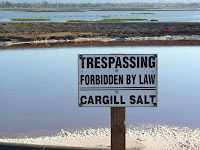Walking Distance: 1.4 mi.
Walking Time: 48 min. (6:15 - 7:03 p.m.) - dawdled; took lots of pictures of bridge
Start and End Point: Parking spot near the foot of Dumbarton Bridge (Menlo Park side); Menlo Park/East Palo Alto, CA
 Almost two years ago, I passed by the Ravenswood Open Space Preserve. The SF2 trail (extending southeast from Dumbarton Bridge) was closed at that time as part of a restoration project.
Almost two years ago, I passed by the Ravenswood Open Space Preserve. The SF2 trail (extending southeast from Dumbarton Bridge) was closed at that time as part of a restoration project.
More recently, the SF2 trail reopened (Fall 2010), and there has been additional construction going on by Caltrans (or Caltrans contractors) at the Dumbarton Bridge, making it difficult to park near this trail. Happily, on this beautiful summer evening, I found a spot amidst the tarps, rebar, and assorted other rubble, and walked the SF2 trail.
 This trail is located on old Cargill Salt ponds and in at least one area, a few traces of the white, crystalline residue (and a no trespassing sign) remain.
This trail is located on old Cargill Salt ponds and in at least one area, a few traces of the white, crystalline residue (and a no trespassing sign) remain.
It looked like interpretive signs were being deployed here over time; benches were installed; and two portable toilets were present. The plan is to return some of the surrounding area (from salt ponds) to marshlands.
 I walked out to the end of this trail (to locked gate) and enjoyed the smattering of wild birds out in the Bay, as well as watching the water whoosh out of a set of pipes from a newly restored marshlands area, back into the Bay. I'm pretty sure this outflow reflected the going out of the tide.
I walked out to the end of this trail (to locked gate) and enjoyed the smattering of wild birds out in the Bay, as well as watching the water whoosh out of a set of pipes from a newly restored marshlands area, back into the Bay. I'm pretty sure this outflow reflected the going out of the tide.
This trail offers excellent views of the new and the old Dumbarton bridge(s) and the San Francisco Bay. I enjoyed the smattering of wild birds out in the Bay.

Wildlife Sightings:

 2 cormorants; 2 willets; 1 little brown job (LBJ); 55 sea gulls; 2 tiny unidentified brownish shorebirds (UBBs), and 14 other UBBs; 4 snowy egrets; 2 white pelicans; 1 tiny "gnat" moth; 1 dragonfly
2 cormorants; 2 willets; 1 little brown job (LBJ); 55 sea gulls; 2 tiny unidentified brownish shorebirds (UBBs), and 14 other UBBs; 4 snowy egrets; 2 white pelicans; 1 tiny "gnat" moth; 1 dragonfly
Walking Time: 48 min. (6:15 - 7:03 p.m.) - dawdled; took lots of pictures of bridge
Start and End Point: Parking spot near the foot of Dumbarton Bridge (Menlo Park side); Menlo Park/East Palo Alto, CA
 Almost two years ago, I passed by the Ravenswood Open Space Preserve. The SF2 trail (extending southeast from Dumbarton Bridge) was closed at that time as part of a restoration project.
Almost two years ago, I passed by the Ravenswood Open Space Preserve. The SF2 trail (extending southeast from Dumbarton Bridge) was closed at that time as part of a restoration project.More recently, the SF2 trail reopened (Fall 2010), and there has been additional construction going on by Caltrans (or Caltrans contractors) at the Dumbarton Bridge, making it difficult to park near this trail. Happily, on this beautiful summer evening, I found a spot amidst the tarps, rebar, and assorted other rubble, and walked the SF2 trail.
 This trail is located on old Cargill Salt ponds and in at least one area, a few traces of the white, crystalline residue (and a no trespassing sign) remain.
This trail is located on old Cargill Salt ponds and in at least one area, a few traces of the white, crystalline residue (and a no trespassing sign) remain.It looked like interpretive signs were being deployed here over time; benches were installed; and two portable toilets were present. The plan is to return some of the surrounding area (from salt ponds) to marshlands.
 I walked out to the end of this trail (to locked gate) and enjoyed the smattering of wild birds out in the Bay, as well as watching the water whoosh out of a set of pipes from a newly restored marshlands area, back into the Bay. I'm pretty sure this outflow reflected the going out of the tide.
I walked out to the end of this trail (to locked gate) and enjoyed the smattering of wild birds out in the Bay, as well as watching the water whoosh out of a set of pipes from a newly restored marshlands area, back into the Bay. I'm pretty sure this outflow reflected the going out of the tide.This trail offers excellent views of the new and the old Dumbarton bridge(s) and the San Francisco Bay. I enjoyed the smattering of wild birds out in the Bay.

Wildlife Sightings:

 2 cormorants; 2 willets; 1 little brown job (LBJ); 55 sea gulls; 2 tiny unidentified brownish shorebirds (UBBs), and 14 other UBBs; 4 snowy egrets; 2 white pelicans; 1 tiny "gnat" moth; 1 dragonfly
2 cormorants; 2 willets; 1 little brown job (LBJ); 55 sea gulls; 2 tiny unidentified brownish shorebirds (UBBs), and 14 other UBBs; 4 snowy egrets; 2 white pelicans; 1 tiny "gnat" moth; 1 dragonfly
















































